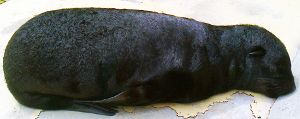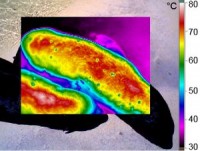Young Cape Fur Seals Handle Heat with Built-in Air Conditioning
 One of the easiest ways to find relief from scorching summer heat is a quick dip in the water. Whether tiger, hippo, or seal, many animals also turn to the water to find relief. However, unlike their adult counterparts, newborn Cape fur seals can’t swim, and intense sun exposure poses a threat of overheating. Luckily, according to a recent PLOS ONE study, these seal pups may have built-in air conditioners, in the form of a furry natal coat, to keep them cool until they learn to stay afloat.
One of the easiest ways to find relief from scorching summer heat is a quick dip in the water. Whether tiger, hippo, or seal, many animals also turn to the water to find relief. However, unlike their adult counterparts, newborn Cape fur seals can’t swim, and intense sun exposure poses a threat of overheating. Luckily, according to a recent PLOS ONE study, these seal pups may have built-in air conditioners, in the form of a furry natal coat, to keep them cool until they learn to stay afloat.
Cape fur seals live in the sunny climes of southern Africa, ranging from the north coast of Namibia, south to the Cape of Good Hope and northeast to Alogoa Bay. Temperatures in these regions can soar above 80° F, and adult seals rely on frequent swims to escape the  sun. An adult spends half its life in the water, but pups are unable to swim until they’re at least 6 weeks old. At this age, coarse water repellent (read: swim-friendly) coats finally grow in to replace their “baby” fur.
sun. An adult spends half its life in the water, but pups are unable to swim until they’re at least 6 weeks old. At this age, coarse water repellent (read: swim-friendly) coats finally grow in to replace their “baby” fur.
Besides making fur seals extra cute and cuddly looking, fur coats may insulate seals from the harsh sun exposure that they are unable to escape from on land. To gain a better understanding of these unique insulating properties, researchers measured temperature daily in several spots on the baby seals, under varying environmental conditions: on the fur surface, within the fur, on the skin and in the rectum. They found that on the warmest days, at an ambient air temperature around 80° F, the pups’ fur measured a whopping 175° F on the surface;  thankfully, this temperature dropped as they measured fur closer to the skin. Within fur, the temperature was a slightly cooler 146° F, and the skin temperature was a more-normal 99.86° F. Internal body temperature remained relatively constant at 98.4° F, indicating that the temperature drastically changed within the fur layer to keep bodies cool. If the seal pups got wet, however, the fur temperature reached 100° F and skin 84° F, showing a reduced ability of fur to insulate when wet. These results support the idea that the furry coat may be an adaptation that provides insulation against overheating during their first six weeks on land.
thankfully, this temperature dropped as they measured fur closer to the skin. Within fur, the temperature was a slightly cooler 146° F, and the skin temperature was a more-normal 99.86° F. Internal body temperature remained relatively constant at 98.4° F, indicating that the temperature drastically changed within the fur layer to keep bodies cool. If the seal pups got wet, however, the fur temperature reached 100° F and skin 84° F, showing a reduced ability of fur to insulate when wet. These results support the idea that the furry coat may be an adaptation that provides insulation against overheating during their first six weeks on land.
If you’re interested in reading more about how other animals keep cool, check out this post about African and Asian elephants.
Erdsack N, Dehnhardt G, Hanke W (2013) Coping with Heat: Function of The Natal Coat of Cape Fur Seal (Arctocephalus Pusillus Pusillus) Pups in Maintaining Core Body Temperature. PLoS ONE 8(8): e72081. doi:10.1371/journal.pone.0072081
Images: 10.1371/journal.pone.0072081
